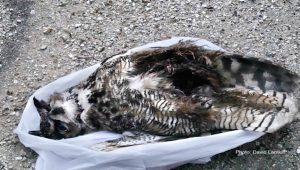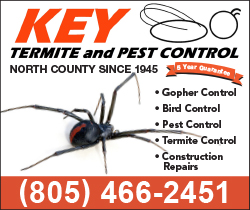Great horned owl found dead from rodenticide poisoning at Sweet Springs Preserve

Testing by the CA Dept of Fish and Wildlife confirmed that this owl died from an anticoagulant rodenticide. “Testing has been completed on the great horned owl. Three different anticoagulant rodenticides were detected in the owls’ liver including Brodifacoum and Difethialone, at relatively high levels, and Bromadiolone, at a trace amount. Given that there was evidence of coagulopathy in the absence of trauma and anticoagulant rodenticides were detected in the liver, cause of death for this owl was anticoagulant rodenticide toxicosis. All three of the rodenticides detected are second generation anticoagulant rodenticides and must be applied by a certified applicator (e.g. pest company) for use in or around buildings or other structures.”
A week later, one of the owlets was found in poor condition on the ground. It was taken to Pacific Wildlife Care. The vet suspected anticoagulant rodenticide poisoning and began treatment with Vitamin K. This saved the life of this little owlet who continues to be cared for in the rehabilitation unit at Pacific Wildlife Care.
Rat poison kills more than rodents. These rodenticides kill rodents by causing them to hemorrhage. This is not an immediate death. The rodents come out of their burrows looking for water. They are weakened and thus are easy prey for predators such as owls, hawks, foxes, even cats, and dogs. The poison is passed on to the animal that eats the poisoned rodent. These poisons do not break down for months, some for more than a year, poisoning every animal that eats a poison-weakened animal.
This owl is only one of many such victims throughout the state. Last October, 21 environmental organizations sent a request to Governor Newsom for an emergency moratorium on these products while the California Department of Pesticide Regulation reevaluates the products as the result of a lawsuit filed by Raptors Are The Solution in 2018. Although the state pulled these dangerous products from consumer shelves in 2014, in a giant loophole they allowed professional companies to continue to use them. In the meantime, hundreds of owls, hawks, bobcats, mountain lions, foxes, and other wildlife are becoming seriously ill or dying after eating poisoned rodents. Thousands of children also become ill each year after consuming these dangerous poisons. Rat poison has infested the food web, from owls to hawks to cats, dogs, mountain lions, bobcats, and endangered species like the Pacific fisher.
Secondary poisoning of predators such as owls and hawks is counter-productive. These raptors are efficient predators. They can each kill and eat over 30 rats every month. By inadvertently poisoning these raptors, we are killing off our best natural predator controls.
There are other ways to keep rodent populations under control.
For the past 10 years, after finding numerous owls and other wildlife poisoned, many CA cities have managed their rodent problems using alternatives to second-generation anticoagulants. Some pest control companies have switched to traps, exclusion, or other less damaging rodent control products.
The first step is to assess the area and remove rodent attractions. Remove access to any other food source. Bring pet food in at night, keep garbage in a tight container, clean up spilled bird seed and fallen fruit. Keep dense mats of vegetation – such as ivy – away from the house foundation. Ivy provides not only shelter, but also food (snails) and water to rodents! Determine where the rodents are entering your house/garage/storage shed. Plug any holes.
Traps: With all traps, you can feed your bait without setting the trap for a few days to accustom the rodents to the trap before you actually set the trap. The dead rodents from these traps are non-toxic to any predator that might eat the dead rodent, so there is no secondary wildlife poisoning.
Snap traps: These come in sizes for both rats and mice. The best location to place them is in a hidden area next to a wall. Rats and mice prefer to keep their bodies in contact with their world, and therefore tend to scurry along walls or dense vegetation rather out into an open space. Change up the bait if they stop taking the one you offer. Keep these away from areas your pets, other wildlife, and children can get into. These are very inexpensive.
Zapper traps: These use batteries to electrocute the rats or mice – a quick death. They cost around $45 and need to have the batteries replaced or recharged often. They are quite effective.
GoodNature A24 CO2 Trap: This trap use a CO2 canister to power a piston that kills the rat or mouse instantly. The trap has the advantage that it “resets” and is ready to go again immediately. It can kill up to 24 rats before needing a new canister. This is rather expensive, but has the advantage of killing many rats/mice in a single night.
Note: Never use sticky traps – they also trap hummingbirds and other small birds!
Attract Barn Owls with a nest box. A single Barn Owl can catch 1,400+ rodents a year!
For more information, visit https://www.raptorsarethesolution.org.
Submitted by the Morro Coast Audubon Society





















